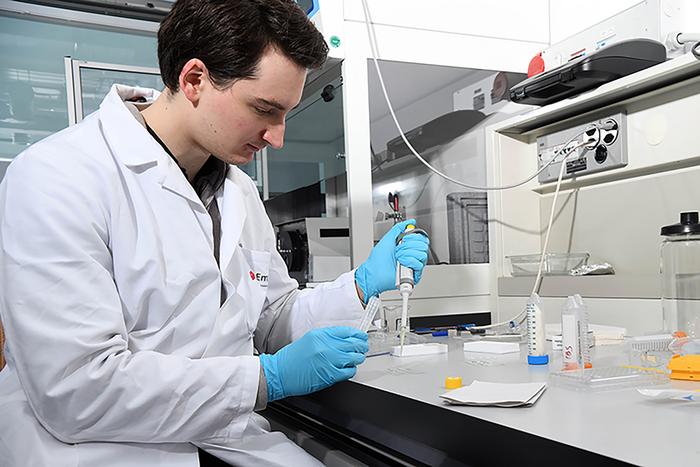In a groundbreaking fusion of biomaterials science and tissue engineering, researchers at Empa—the Swiss Federal Laboratories for Materials Science and Technology—have developed a novel hydrogel derived from cold-water fish gelatin that promises to revolutionize the field of 3D bioprinting. This innovation is set to significantly enhance the creation of artificial human skin models, a critical step forward for both dermatological research and therapeutic wound care. Unlike conventional hydrogels, which often swell and deform when exposed to liquids, this new material exhibits exceptional mechanical robustness and non-swelling properties, making it ideally suited for precise 3D printing applications.
The skin, as the largest organ of the human body, serves as a complex protective barrier against environmental threats such as pathogens, dehydration, and temperature fluctuations. Despite its vital role, the intricate biological mechanisms underpinning skin diseases—including skin cancer, chronic wounds, and autoimmune disorders—remain only partially understood. To bridge this gap, Empa scientists have embarked on an ambitious project in collaboration with clinical partners to engineer a living, multilayered artificial skin model. This model is designed to emulate the intricate architecture and biochemical environment of natural human skin, enabling researchers to simulate disease mechanisms with unprecedented fidelity.
This particular fish-derived gelatin can be cross-linked swiftly and efficiently into a hydrogel that resists swelling post-fabrication. The materials science team utilized this characteristic to produce a hydrogel matrix that preserves its form during and after 3D bioprinting. The ability to maintain dimensional stability while embedding living skin cells is a major leap forward, facilitating the construction of biomimetic skin that includes the vital dermis, epidermis, and the critical epidermal-dermal junction, often referred to as the basal membrane. Such structural fidelity is crucial for studying cell-cell interactions and pathological changes that occur at these interfaces in various skin conditions.
The employment of 3D printing technology adds another layer of sophistication to this model. This additive manufacturing method facilitates precise spatial arrangement of multiple cell types within the hydrogel, recapitulating the natural heterogeneity of human skin tissue. Three-dimensional bioprinting empowers researchers to place skin cells, extracellular matrix substitutes, and other biomaterials in tailored patterns, closely mirroring the organized complexity of real skin. The technique’s flexibility also enables the integration of multiple polymers and cellular components within a single construct, pushing the envelope of tissue engineering capabilities.
One of the most remarkable aspects of this development is the hydrogel’s compatibility with living cells, which broadens its applications beyond model skin fabrication. By omitting live cells during production, the fish gelatin hydrogel can serve as an advanced wound dressing. Its biological compatibility reduces the likelihood of immune rejection while minimizing risks related to disease transmission that are typically associated with mammalian gelatin derivatives due to evolutionary distances. This positions the material as a safer, more homogeneous alternative to currently available biologically derived dressings.
Moreover, the intrinsic properties of this hydrogel allow it to be customized with precision to meet patient-specific needs. Variables such as thickness, stiffness, and shape can be finely tuned, opening possibilities for highly personalized wound care solutions. Inclusion of therapeutic agents—ranging from antibiotics to growth factors—within the hydrogel matrix is also under consideration, which could transform wound dressings into active treatment systems that accelerate healing and reduce complications.
The inspiration behind leveraging cold-water fish gelatin stems from its evolutionary divergence from mammals, which reduces immunogenic potential. Empa’s interdisciplinary team, operating within the Swiss research initiative SKINTEGRITY.CH, has tapped into this natural resource to yield a biomaterial exhibiting both mechanical resilience and biofunctionality. Their approach aligns with SKINTEGRITY.CH’s mission to elucidate molecular-level skin responses during injury, disease, and healing by providing researchers with more accurate and representative skin models.
Beyond laboratory research, empirical validation and patent protection efforts are underway. The research team has filed a patent application to safeguard their novel hydrogel formulation, aimed at facilitating widespread adoption in both academic and commercial sectors. Future work revolves around completing the development of the living skin model and distributing it to fellow scientists globally, accelerating translational research into skin diseases and therapeutic interventions.
Additionally, the team is intrigued by the peculiar swelling dynamics of their hydrogel, which diverge from typical polymer behavior. Detailed biophysical studies are planned to investigate these phenomena, with expectations that insights gained might inform further optimization not only for skin models but also for other tissue engineering applications requiring stable biomimetic scaffolds.
In sum, Empa’s breakthrough in creating a mechanically robust, non-swelling hydrogel derived from cold-water fish gelatin, optimized for 3D bioprinting, offers transformative possibilities for the future of skin disease research, wound healing, and regenerative medicine. By faithfully replicating the structure and conditions of human skin within a synthetic platform, scientists can explore disease progression, drug responses, and repair mechanisms more effectively and ethically. As this technology matures, it could herald a new era where personalized, bioprinted skin grafts and advanced wound dressings become commonplace tools in clinical settings.
—
Subject of Research: Cells
Article Title: Mechanically robust non-swelling cold water fish gelatin hydrogels for 3D bioprinting
News Publication Date: 2-Jun-2025
Web References:
http://dx.doi.org/10.1016/j.mtbio.2025.101701
Image Credits: Empa
Keywords
3D bioprinting, cold-water fish gelatin, hydrogel, skin model, extracellular matrix, non-swelling hydrogel, tissue engineering, wound healing, biomaterials, SKINTEGRITY.CH, regenerative medicine, biomimetic skin
Tags: 3D bioprinting innovationsartificial skin models for wound carecold-water fish gelatin biomaterialsdermatological research advancementsEmpa research collaborationhydrogel-based artificial skinmechanical properties of hydrogelsmultilayered skin model engineeringnon-swelling hydrogel applicationsprotective barrier function of skinskin disease simulation techniquestissue engineering breakthroughs





